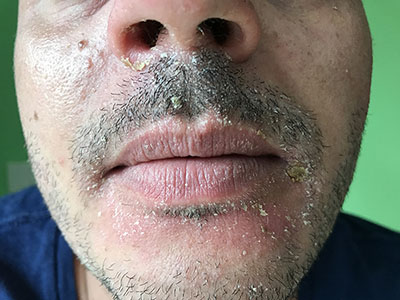
Seborrhea faciei or Seborrhea of the face, most commonly known as Seborrheic dermatitis of the face, is a common skin condition that affects the oily areas of the face, such as the forehead, nose, and cheeks. It is characterized by red, greasy skin with yellow or white scales. Seborrhea is usually mild and can be controlled with over-the-counter treatments. However, in severe cases, it may require prescription medication.
Signs and Symptoms
- Red, greasy skin
- Yellow or white scales
- Itchy skin
- Burning or stinging sensation
- Flaky patches
- Dandruff
Causes
The exact cause of seborrhea faciei is unknown, but it is thought to be caused by a combination of factors, including:
- Overproduction of sebum, the oil produced by the skin glands
- Overgrowth of the Malassezia yeast, which normally lives on the skin
- Hormonal changes
- Genetics
- Stress
- Certain medications
Diagnosis
The diagnosis of seborrhea of the face is usually based on a physical examination of the skin. In some cases, a doctor may also take a skin scraping to look for the Malassezia yeast under a microscope.
Nursing Interventions
Education
- Educate the patient about seborrheic dermatitis of the face, including the causes, symptoms, and treatment options.
- Instruct the patient on how to properly wash their face and scalp.
- Recommend that the patient use oil-free and non-comedogenic (does not clog pores) moisturizers and sunscreens.
- Advise the patient to avoid harsh soaps, detergents, and alcohol-based products.
- Encourage the patient to manage stress, as stress can worsen seborrhea symptoms.
Skin care
- Cleanse the affected skin with a mild soap twice a day.
- Apply a topical antifungal cream or shampoo as prescribed by the doctor.
- Use a moisturizer that is oil-free and non-comedogenic.
- Avoid picking at or scratching the affected skin.
- Protect the skin from the sun by wearing a sunscreen with an SPF of 30 or higher.
Lifestyle modifications
- Advice patient to manage stress.
- Advice patient to eat a healthy diet that is low in processed foods and sugar.
- Advice patient to get regular exercise.
- Advice patient to get enough sleep.
Monitoring
- Monitor the patient's skin for any signs of infection, such as redness, swelling, or pus.
- Assess the patient's response to treatment and make adjustments as needed.
Additional considerations
- If the patient is also experiencing hair loss, recommend that they see a dermatologist or trichologist.
- If the patient is pregnant or breastfeeding, consult with a doctor before using any topical medications.
Referral
- If the patient's seborrhea is severe or does not respond to treatment, refer them to a dermatologist.
Treatment
There is no cure for seborrhea faciei, but treatment can help to control the symptoms. Treatment options may include:
- Over-the-counter antifungal creams or shampoos
- Prescription antifungal creams or shampoos
- Topical corticosteroids
- Oral medications
In addition to medication, there are some things you can do at home to help control seborrheic dermatitis of the face, such as:
- Washing your face twice a day with a mild soap
- Avoiding harsh soaps and detergents
- Using a moisturizer that is oil-free and non-comedogenic (does not clog pores)
- Shampooing your hair regularly with an antifungal shampoo
- Managing stress
Prognosis
While there is no permanent treatment for seborrhea faciei, the prognosis for seborrhea of the face is generally good. Most people with seborrheic dermatitis of the face can control their symptoms with treatment. However, seborrhea is a chronic condition and may flare up from time to time.